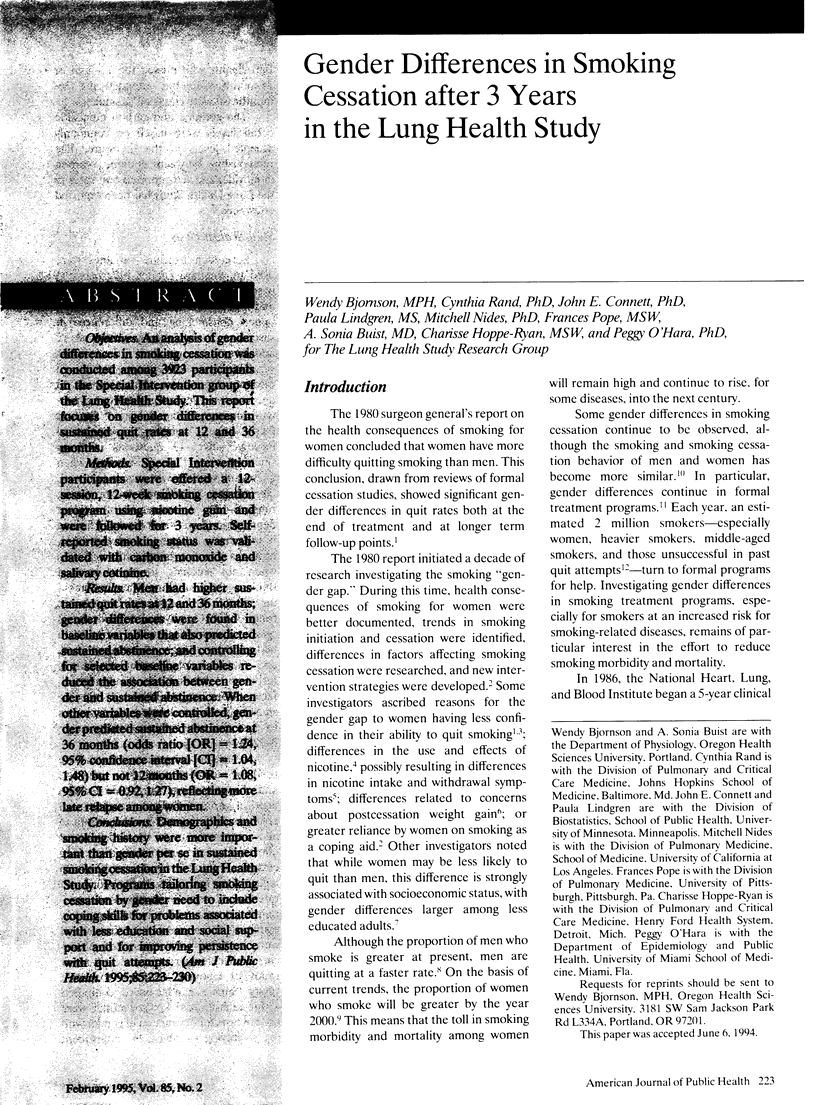Gender differences in smoking cessation after 3 years in the Lung Health Study (original) (raw)
Abstract
OBJECTIVES. An analysis of gender differences in smoking cessation was conducted among 3923 participants in the Special Intervention group of the Lung Health Study. This report focuses on gender differences in sustained quit rates at 12 and 36 months. METHODS. Special Intervention participants were offered a 12-session, 12-week smoking cessation program using nicotine gum and were followed for 3 years. Self-reported smoking status was validated with carbon monoxide and salivary cotinine. RESULTS. Men had higher sustained quit rates at 12 and 36 months; gender differences were found in baseline variables that also predicted sustained abstinence; and controlling for selected baseline variables reduced the association between gender and sustained abstinence. When other variables were controlled, gender predicted sustained abstinence at 36 months (odds ratio [OR] = 1.24, 95% confidence interval [CI] = 1.04, 1.48) but not 12 months (OR = 1.08, 95% CI = 0.92, 1.27), reflecting more late relapse among women. CONCLUSIONS. Demographics and smoking history were more important than gender per se in sustained smoking cessation in the Lung Health Study. Programs tailoring smoking cessation by gender need to include coping skills for problems associated with less education and social support and for improving persistence with quit attempts.

Selected References
These references are in PubMed. This may not be the complete list of references from this article.
- Blake S. M., Klepp K. I., Pechacek T. F., Folsom A. R., Luepker R. V., Jacobs D. R., Mittelmark M. B. Differences in smoking cessation strategies between men and women. Addict Behav. 1989;14(4):409–418. doi: 10.1016/0306-4603(89)90028-2. [DOI] [PubMed] [Google Scholar]
- Buist A. S., Connett J. E., Miller R. D., Kanner R. E., Owens G. R., Voelker H. T. Chronic Obstructive Pulmonary Disease Early Intervention Trial (Lung Health Study). Baseline characteristics of randomized participants. Chest. 1993 Jun;103(6):1863–1872. doi: 10.1378/chest.103.6.1863. [DOI] [PubMed] [Google Scholar]
- Cohen S., Lichtenstein E., Prochaska J. O., Rossi J. S., Gritz E. R., Carr C. R., Orleans C. T., Schoenbach V. J., Biener L., Abrams D. Debunking myths about self-quitting. Evidence from 10 prospective studies of persons who attempt to quit smoking by themselves. Am Psychol. 1989 Nov;44(11):1355–1365. doi: 10.1037//0003-066x.44.11.1355. [DOI] [PubMed] [Google Scholar]
- Coppotelli H. C., Orleans C. T. Partner support and other determinants of smoking cessation maintenance among women. J Consult Clin Psychol. 1985 Aug;53(4):455–460. doi: 10.1037//0022-006x.53.4.455. [DOI] [PubMed] [Google Scholar]
- Enright P. L., Johnson L. R., Connett J. E., Voelker H., Buist A. S. Spirometry in the Lung Health Study. 1. Methods and quality control. Am Rev Respir Dis. 1991 Jun;143(6):1215–1223. doi: 10.1164/ajrccm/143.6.1215. [DOI] [PubMed] [Google Scholar]
- Fiore M. C., Novotny T. E., Pierce J. P., Giovino G. A., Hatziandreu E. J., Newcomb P. A., Surawicz T. S., Davis R. M. Methods used to quit smoking in the United States. Do cessation programs help? JAMA. 1990 May 23;263(20):2760–2765. [PubMed] [Google Scholar]
- Fiore M. C., Novotny T. E., Pierce J. P., Hatziandreu E. J., Patel K. M., Davis R. M. Trends in cigarette smoking in the United States. The changing influence of gender and race. JAMA. 1989 Jan 6;261(1):49–55. [PubMed] [Google Scholar]
- Grunberg N. E., Winders S. E., Wewers M. E. Gender differences in tobacco use. Health Psychol. 1991;10(2):143–153. [PubMed] [Google Scholar]
- Hatziandreu E. J., Pierce J. P., Lefkopoulou M., Fiore M. C., Mills S. L., Novotny T. E., Giovino G. A., Davis R. M. Quitting smoking in the United States in 1986. J Natl Cancer Inst. 1990 Sep 5;82(17):1402–1406. doi: 10.1093/jnci/82.17.1402. [DOI] [PubMed] [Google Scholar]
- Heatherton T. F., Kozlowski L. T., Frecker R. C., Rickert W., Robinson J. Measuring the heaviness of smoking: using self-reported time to the first cigarette of the day and number of cigarettes smoked per day. Br J Addict. 1989 Jul;84(7):791–799. doi: 10.1111/j.1360-0443.1989.tb03059.x. [DOI] [PubMed] [Google Scholar]
- Murray R. P., Connett J. E., Lauger G. G., Voelker H. T. Error in smoking measures: effects of intervention on relations of cotinine and carbon monoxide to self-reported smoking. The Lung Health Study Research Group. Am J Public Health. 1993 Sep;83(9):1251–1257. doi: 10.2105/ajph.83.9.1251. [DOI] [PMC free article] [PubMed] [Google Scholar]
- O'Hara P., Grill J., Rigdon M. A., Connett J. E., Lauger G. A., Johnston J. J. Design and results of the initial intervention program for the Lung Health Study. The Lung Health Study Research Group. Prev Med. 1993 May;22(3):304–315. doi: 10.1006/pmed.1993.1025. [DOI] [PubMed] [Google Scholar]
- Pierce J. P., Fiore M. C., Novotny T. E., Hatziandreu E. J., Davis R. M. Trends in cigarette smoking in the United States. Educational differences are increasing. JAMA. 1989 Jan 6;261(1):56–60. [PubMed] [Google Scholar]
- Pierce J. P., Fiore M. C., Novotny T. E., Hatziandreu E. J., Davis R. M. Trends in cigarette smoking in the United States. Projections to the year 2000. JAMA. 1989 Jan 6;261(1):61–65. [PubMed] [Google Scholar]
- Pirie P. L., McBride C. M., Hellerstedt W., Jeffery R. W., Hatsukami D., Allen S., Lando H. Smoking cessation in women concerned about weight. Am J Public Health. 1992 Sep;82(9):1238–1243. doi: 10.2105/ajph.82.9.1238. [DOI] [PMC free article] [PubMed] [Google Scholar]
- Pomerleau C. S., Pomerleau O. F., Garcia A. W. Biobehavioral research on nicotine use in women. Br J Addict. 1991 May;86(5):527–531. doi: 10.1111/j.1360-0443.1991.tb01802.x. [DOI] [PubMed] [Google Scholar]
- Sorensen G., Pechacek T. F. Attitudes toward smoking cessation among men and women. J Behav Med. 1987 Apr;10(2):129–137. doi: 10.1007/BF00846421. [DOI] [PubMed] [Google Scholar]